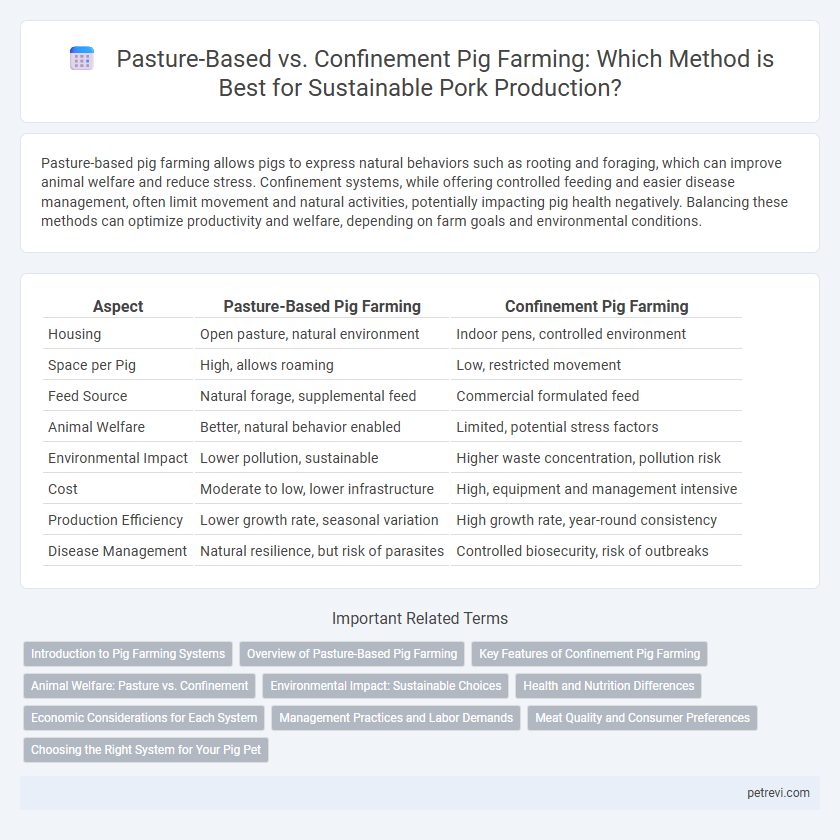Pasture-based pig farming allows pigs to express natural behaviors such as rooting and foraging, which can improve animal welfare and reduce stress. Confinement systems, while offering controlled feeding and easier disease management, often limit movement and natural activities, potentially impacting pig health negatively. Balancing these methods can optimize productivity and welfare, depending on farm goals and environmental conditions.
Table of Comparison
| Aspect | Pasture-Based Pig Farming | Confinement Pig Farming |
|---|---|---|
| Housing | Open pasture, natural environment | Indoor pens, controlled environment |
| Space per Pig | High, allows roaming | Low, restricted movement |
| Feed Source | Natural forage, supplemental feed | Commercial formulated feed |
| Animal Welfare | Better, natural behavior enabled | Limited, potential stress factors |
| Environmental Impact | Lower pollution, sustainable | Higher waste concentration, pollution risk |
| Cost | Moderate to low, lower infrastructure | High, equipment and management intensive |
| Production Efficiency | Lower growth rate, seasonal variation | High growth rate, year-round consistency |
| Disease Management | Natural resilience, but risk of parasites | Controlled biosecurity, risk of outbreaks |
Introduction to Pig Farming Systems
Pasture-based pig farming allows pigs to forage naturally, promoting animal welfare and reducing feed costs, while enhancing soil fertility through manure distribution. Confinement systems offer controlled environments that optimize growth rates, biosecurity, and feed efficiency but require significant investment and management. Choosing between these systems depends on factors such as climate, land availability, market demands, and sustainability goals in pig production.
Overview of Pasture-Based Pig Farming
Pasture-based pig farming leverages natural grazing environments to enhance animal welfare and promote sustainable agriculture. Pigs in pasture systems exhibit natural behaviors, improved health, and produce meat with distinct flavor profiles enriched by diverse foraging. This method reduces feed costs and environmental pollution compared to confinement systems, supporting biodiversity and soil fertility through natural rooting and manure distribution.
Key Features of Confinement Pig Farming
Confinement pig farming involves raising pigs in controlled indoor environments, ensuring consistent temperature, ventilation, and hygiene that reduce disease risks and promote faster growth. This method leverages automated feeding, watering systems, and waste management technologies to optimize productivity and resource efficiency. Confinement systems enable precise monitoring of animal health and feed intake, increasing overall farm profitability and reducing labor costs.
Animal Welfare: Pasture vs. Confinement
Pasture-based pig farming enhances animal welfare by allowing natural behaviors such as rooting, foraging, and social interaction, which are restricted in confinement systems. Confinement often leads to stress, limited mobility, and higher incidences of aggression or injury due to overcrowding and lack of environmental enrichment. Studies indicate that pigs raised on pasture exhibit better overall health, lower stress hormone levels, and improved immune function compared to those in confined housing.
Environmental Impact: Sustainable Choices
Pasture-based pig farming enhances soil health by promoting natural nutrient cycling and reducing reliance on synthetic fertilizers, while confinement systems often generate concentrated waste leading to environmental pollution risks. Methane emissions tend to be lower in pasture-based operations due to increased manure aeration and natural degradation processes. Sustainable pig farming choices prioritize pasture systems to improve biodiversity, reduce greenhouse gas emissions, and minimize water contamination compared to intensive confinement practices.
Health and Nutrition Differences
Pasture-based pig farming promotes natural foraging, resulting in diverse nutrient intake and enhanced gut health, which reduces the need for antibiotics. Confinement systems often rely on formulated feeds, ensuring consistent nutrient supply but increasing stress and susceptibility to diseases due to limited space. Health outcomes in pasture-raised pigs generally include stronger immune systems and lower incidence of respiratory issues, while confinement pigs may experience higher growth rates but greater risk of infections.
Economic Considerations for Each System
Pasture-based pig farming often requires lower initial capital investment due to minimal infrastructure costs but may incur higher land expenses and variable feed costs depending on forage availability. Confinement systems demand significant upfront costs for housing, equipment, and waste management but can achieve higher feed efficiency and greater control over growth rates, impacting overall profitability. Economic viability depends on factors such as feed prices, labor costs, market demand, and environmental regulations, which influence the cost-benefit balance between pasture-based and confinement pig production.
Management Practices and Labor Demands
Pasture-based pig farming emphasizes rotational grazing, which enhances soil health and reduces feed costs but requires intensive labor for fence maintenance and daily animal monitoring. Confinement systems streamline feeding and waste management with automated technologies, lowering labor intensity but increasing operational complexity and biosecurity measures. Effective management in pasture-based systems relies on adaptive strategies to balance forage availability and animal welfare, while confinement focuses on optimizing environmental controls and health surveillance.
Meat Quality and Consumer Preferences
Pasture-based pig farming enhances meat quality by promoting firmer texture and richer flavor due to natural foraging and exercise, which increases omega-3 fatty acids and antioxidants in the pork. Consumers often prefer pasture-raised pork for its perceived health benefits and ethical production, resulting in higher willingness to pay and market demand. In contrast, confinement systems prioritize efficiency and consistency but may yield pork with less favorable sensory and nutritional attributes.
Choosing the Right System for Your Pig Pet
Pasture-based pig farming offers pigs natural foraging opportunities and improved animal welfare through outdoor access, while confinement systems provide controlled environments that optimize space and biosecurity. Choosing the right system for your pig pet depends on factors like available land, climate, and desired level of human-animal interaction. Consider balancing natural behaviors with management efficiency to ensure the health and well-being of your pig pet.
Pasture-based vs Confinement for Pig farming Infographic

 petrevi.com
petrevi.com